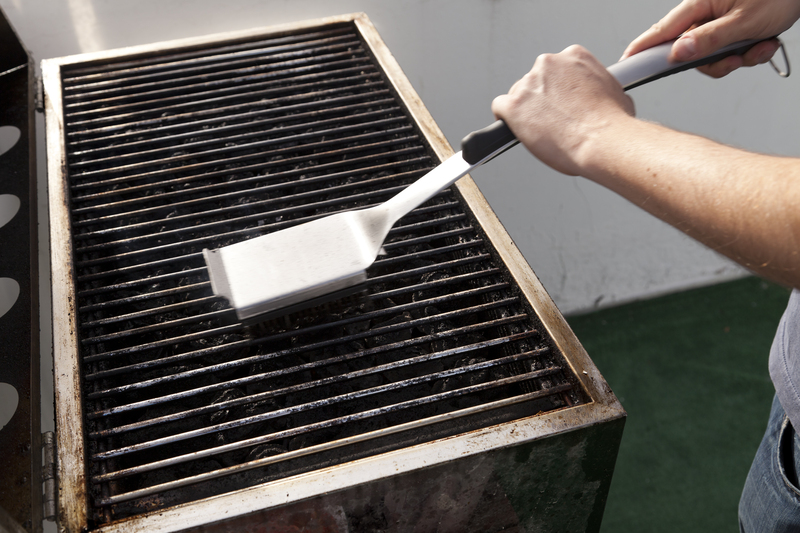Easy Techniques to Clean Burnt-on Residue from Your Stovetop
Posted on 21/05/2025
Easy Techniques to Clean Burnt-on Residue from Your Stovetop
Dealing with a dirty stovetop, especially when it is covered in burnt-on messes, can be a challenging household task. If you're wondering how to clean burnt-on residue from your stovetop efficiently, you have come to the right place. This article will show you a range of easy techniques to remove stubborn, cooked-on grime from any stovetop surface, whether it's gas, electric, or glass.

Why It's Important to Keep Your Stovetop Clean
- Prolongs Appliance Life: Regular cleaning prevents build-up that can corrode stove materials.
- Reduces Health Risks: A clean surface means bacteria and mold don't stand a chance.
- Improves Kitchen Aesthetics: A sparkling stovetop makes your entire kitchen look tidy.
- Prevents Bad Odors: Burnt residue can produce persistent, unpleasant smells.
Learning how to clean burnt-on food off your stovetop not only keeps your kitchen sanitary but also enhances your cooking experience.
Understanding the Types of Stovetop Residue
Stains and residues come in many forms:
- Sugar burns: Sticky and hard to remove
- Grease spills: Creates a stubborn layer if not cleaned quickly
- Boiled over liquids: Can be both oily and crusty
- Baked-on sauces: Often require soaking
Identifying the type of burnt-on mess helps you choose the right method for cleaning your stovetop.
Preparation: Before You Start Cleaning
Before using any burnt-on food remover for stovetops, follow these steps:
- Turn Off and Cool Down: Ensure the stovetop is off and completely cool to avoid burns.
- Remove Components: Take off burners, grates, and any removable knobs for easier access.
- Assemble Supplies: Gather non-abrasive sponges, baking soda, white vinegar, dish soap, razor blades, and microfiber cloths.
Setting the stage for easy stovetop cleaning makes the job simpler and more effective.
Easy Home Remedies for Cleaning Burnt Stovetops
1. Baking Soda and Vinegar Magic
Baking soda and white vinegar are kitchen staples for natural and effective cleaning. These simple ingredients create a fizzing action that lifts stains effortlessly.
Follow these steps:
- Sprinkle baking soda generously over the burnt-on spots.
- Spray white vinegar over the baking soda until it sizzles.
- Let the mixture sit for 15-20 minutes to break down tough residue.
- Wipe away with a non-scratch sponge or cloth.
- Repeat if necessary for stubborn spots.
This technique gently removes burnt-on food from glass and ceramic stovetops without scratching.
2. Soapy Hot Water Soak
For particularly tough dirt, a hot water soak does wonders:
- Mix a few drops of dish soap in a bowl of hot water.
- Saturate a towel in the solution and lay it over the dirty spots.
- Let the towel rest for 20-30 minutes to loosen crusted food and stains.
- Wipe and scrub gently with a soft sponge.
This method is safe for enamel and porcelain stovetops.
3. The Razor Blade Technique (For Glass and Induction Stovetops)
For burnt-on residue that just won't budge, a razor blade scraper is the secret weapon. Always use caution and a special stovetop-safe blade:
- Hold the blade at a 45-degree angle.
- Gently scrape off the burnt crust, being careful not to scratch the surface.
- Wipe away debris with a microfiber cloth.
Pro tip: Only use razor blades on flat glass or induction cooktops, never on gas burners or textured surfaces!
4. Commercial Stove Cleaners
If home remedies aren't cutting it, there are many effective stovetop cleaners available at stores:
- Follow all manufacturer instructions carefully.
- Choose non-abrasive formulas for glass and ceramic stovetops.
- Always spot-test on a small area first to avoid damage.
Commercial products can make removing cooked-on spills and burnt grease from your stovetop easier and quicker.
5. Lemon Power for Natural Cleaning
Lemons are packed with citric acid, making them natural degreasers:
- Slice a lemon in half and rub it over stained areas.
- Allow the juice to sit for a few minutes.
- Wipe clean with a damp cloth for a sparkling finish.
Lemon is especially effective for light burnt-on spills and leaves a pleasant, fresh scent.
Differentiating by Stovetop Material
1. How to Clean Burnt Residue from Gas Stovetops
Gas stovetops are durable but prone to grime buildup around burners and grates. Here's how to tackle them:
- Remove grates and burner caps and soak in hot, soapy water for 30 minutes.
- Scrub gently with a soft bristle brush or sponge to remove stuck-on debris.
- Use baking soda paste to clean the main stovetop surface.
- Dry all parts thoroughly before reassembling to prevent rust.
Never let water seep into gas burners.
2. How to Remove Burnt-on Stains from Electric Coil Stovetops
Electric coil stoves can collect cooked-on spills under and around the coils. Here's a foolproof cleaning plan:
- Once COMPLETELY cool, remove coils per manufacturer's instructions.
- Clean drip pans and coils with a damp cloth and mild detergent (do not immerse coils in water).
- Soak and scrub drip pans with baking soda paste or vinegar for heavy stains.
- Wipe down the entire surface before replacing coils.
3. Cleaning Glass and Ceramic Stovetops
Glass and ceramic cooktops require extra care to prevent scratches and streaks:
- Use only non-abrasive sponges and a gentle touch.
- Apply a paste of baking soda and water to burnt stains, then wipe clean.
- For a streak-free finish, polish with a dry microfiber cloth.
Specialized Tips for Extra Burnt or Tough Stains
Overnight Soak for Maximum Cleaning
For thick, charred burnt-on residue, sometimes time is your best friend:
- Apply a thick paste of baking soda and water over the stained area.
- Cover with plastic wrap and let sit overnight.
- Wipe away the paste with a damp cloth; repeat if necessary.
Try Hydrogen Peroxide for Stubborn Stains
Hydrogen peroxide is a gentle chemical cleaner:
- Sprinkle baking soda, then pour hydrogen peroxide over it.
- Let the mix bubble for about 10-15 minutes to lift grime.
- Scrub with a soft sponge and wipe clean.
Hydrogen peroxide is safe for most surfaces, but spot test first.
How to Maintain a Spotless Stovetop
Prevention is the best way to avoid burnt-on residue. Here are some maintenance tips:
- Wipe spills immediately: The quicker you clean up, the less likely foods will burn on.
- Use drip pans and covers: Protect surfaces and simplify cleanup.
- Deep clean regularly: Schedule a thorough cleaning weekly or bi-weekly.
- Inspect burners: Ensure no-food debris blocks gas or electric flow.
Make post-meal wipe-downs a habit, and you'll rarely need to deal with severe burnt-on messes.
Common Mistakes to Avoid When Cleaning Burnt Stovetops
- Using excessive force: Scrubbing too hard can scratch or damage surfaces.
- Applying abrasive pads: Steel wool and rough scrubbers destroy glass and enamel finishes.
- Mixing harsh chemicals: Bleach and ammonia should not be combined.
- Skipping spot tests: Always test new cleaners on a hidden area first.
- Forgetting to dry thoroughly: Moisture can cause rust on metal parts and promote mold.

Frequently Asked Questions About Cleaning Burnt-on Residue
- Can baking soda scratch my glass stovetop?
Baking soda is only mildly abrasive and generally safe, but always use a soft, damp sponge to avoid scratches. - What if the burnt-on residue still won't come off?
Persistent stains may require several treatments or a strong commercial cleaner. For delicate surfaces, contact the manufacturer for advice. - Will vinegar damage my stovetop?
Vinegar is safe for most stovetops but can dull unsealed stone or metal. Always rinse and dry afterwards.
Conclusion: Simplify Your Kitchen Cleanup Routine
With the easy techniques to clean burnt-on residue from your stovetop outlined above, you can conquer even the toughest messes quickly and safely. By using everyday household supplies like baking soda, vinegar, and lemon, as well as a few specialty tools and products, you can restore your stovetop to a sparkling, like-new shine! Establishing regular cleaning habits is the ultimate key to keeping your kitchen fresh and inviting. So, say goodbye to stubborn stains and enjoy a gleaming stovetop for every meal!
Ready to tackle your kitchen messes? Refer to this guide whenever you need to remove burnt-on food, scorch marks, or greasy buildup from your stovetop and keep your cooking space at its very best!




